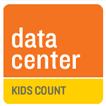This interactive website for KIDS Count, a project through the Annie E. Casey Foundation, provides ten years of data on child well-being nationally and in each of the 50 states, as well as the District of Columbia and Puerto Rico. Data are available for 51 indicators in six topic areas: (1) demographics; (2) economic well-being, (3) education, (4) family and community, (5) health, and (6) safety and risky behaviors. Data are also available by characteristics: (1) age, (2) family nativity, and (3) race and ethnicity. The site presents indicator data at the state level as well as breakdowns by location (e.g., county, city, and Congressional district), topic, and child/family characteristics. It also provides State rankings for the indicators.
States can use the state- and city/county-level data for comparison on a number of indicators relevant to early intervention, including those related to low birthweight, enrollment in Medicaid and CHIP, lack of insurance, poverty, receipt of public assistance and enrollment in early education programs. For example, a state with high incidence of low-birthweight or high poverty can determine which other states are at similar levels. This could lead to dialogue or other problem-solving methods. This can also aid states in determining whether certain subgroups of children are under- or over-represented in comparison to other states and nationally. The historical data provided also allows for comparison across years.
Published by: KIDS COUNT Data Center, A Project of the Annie E. Casey Foundation


